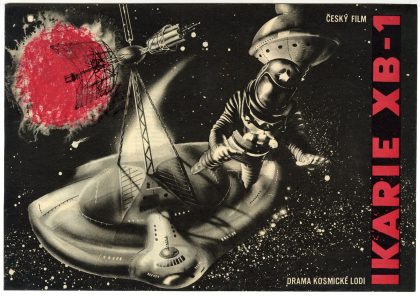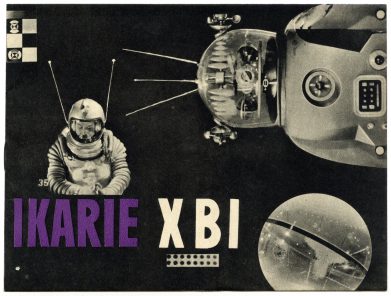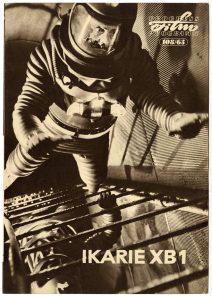Taking place on a spaceship heading to planets of Alfa Centauri in 2163, Jindřich Polák and Pavel Juráček’s philosophical sci-fi film was for a long time the first serious attempt at a representative of a rarely explored genre in Czechoslovakia.
Considering the lack of a sci-fi tradition, it was not an easy task to push Ikarie XB 1 through. Moreover, the film didn’t meet with much understanding from domestic critics after the première. Narrated in a slow and serious way, for many foreign critics and viewers the sci-fi was something unique they couldn’t compare to anything they had seen before in this genre. Kubrick’s 2001: A Space Odyssey, which was comparably consequent in respecting scientific knowledge, was only made five years later.
The interest in space travel was triggered by releasing the first artificial satellite in 1957. Along with other countries of the Eastern Bloc, Czechoslovakia also decided to contribute with a post-Sputnik film. However, the intention to present to the Soviet Union and juries of Western festivals a film which could easily be used as a tool of propaganda in the space race (won by the Soviet Union, naturally) didn’t quite turn out as planned by the Barrandov Studio management.
The initiator of the first actual Czechoslovak sci-fi film was the director Jindřich Polák, who simply wanted to try out a new genre (having made the Eastern Death in the Saddle (Smrt v sedle, 1958) and the crime film The Fifth Department, (Páté oddělení, 1960) before). Following the recommendation of his teacher František Daniel, Pavel Juráček – a third-year dramaturgy student at the Film and TV School of the Academy of Performing Arts in Prague (FAMU) – took on the task of writing the literary basis for the film based on Polák’s favourite book, To the Magellan Cloud (K mrakům Magellanovým, written by Stanisław Lem), as his graduate scenario.
The adaptation of the book describing an exploratory space journey was first written in 1959 as a short film story. Even though the characters‘ names and many aspects of the story had been changed, the Barrandov Studio dramaturgic team considered it appropriate to negotiate the sale of copyright with Lem. No agreement was made though, so Juráček had a free hand to develop the situation and interpret the meaning of Lem’s book.
Even though the Barrandov Studio management had an interest in making the sci-fi film, Juráček faced mistrust and misgivings during the approval process. Some opined that the first version of the story lacked a clear intention and more elaborated description of the characters. According to Juráček’s colleagues, the film’s „key ideas“ and characters were not developed enough in the second version either, which the young author finished in June 1960. They also feared it wouldn’t be possible to materialize abstract ideas into visual scenes and understandable dialogue.
Juráček presented the third version of the story for assessment in November 1960, only to hear that it had been written with little imagination and wasn’t well-arranged enough. More constructive feedback was given by the film critic A. J. Liehm, who recommended discussing the key ideas with Czechoslovak philosophers, such as Arnošt Kolman or Gustav Bareš. After many modifications, Pavel Juráček and Jindřich Polák’s literary screenplay was approved in early March 1961. Then came yet another round of opinions and rewriting.
Many expressed concern mainly that the subject matter was overly complicated; this would be a reason for delays and hesitation in Juráček’s later films as well. But in July 1961, Juráček’s vision was understood by his peer Jan Procházka. According to him, the literary screenplay promised a good and thrilling film. On 1 August 1961, not long after Procházka’s dramaturgic analysis, preparatory work started under the Šebor–Bor production team. At that time, the film had the less technical working title Silver Comet (Stříbrná kometa); another working title was In 200 Years Towards the End of June (Za 200 let koncem června).
Just before the end of 1961, the Barrandov Film Studio director approved a budget of CSK 5 million for the emerging project and the Filmové informace magazine informed about the beginning of filming, describing the author’s intention. According to the text beginning with the question „What will people be like in fifty years?“, the film was meant to present a picture of the future world according to modern science. The explication continued with an assumption that „as long as humans are humans, they will be fighting for happiness, appreciation, popularity, women – albeit maybe on another level and without unfair punches.“[1]
The technical screenplay was approved on 16 January 1962. Less than a month later, the filming was already in progress on a deliberately austere stage made in „Brussels style“ by the architect Jan Zázvorka Jr. (Stella Zázvorková’s brother).[2] The relatively long filming only ended after ten months, in December 1962. The subsequent four months were dedicated to post-production works, including the creation of trick shots and recording of Zdeněk Liška’s minimalist music.
The first copy of the film was produced at the end of March 1963. Approved by the Central Press Supervision Office, Ikarie XB 1 could be passed to the Central Film Lending Office. The first ceremonial screening took place in June in a Czechoslovak cultural centre in the GDR. At the beginning of summer 1963, Ikarie was also screened at the Workers‘ Film Festival. The film premièred in Czechoslovak cinemas on 26 July 1963. Ikarie was screened together with the documentary The Most Ordinary of Occupations (Nejvšednější povolání, 1963).
By the end of 1964, the film had earned a little under CSK 2 million in Czechoslovak cinemas. In addition to East German and Czechoslovak audiences, it was gradually seen by Japanese, American, Italian, Belgian, British, Swiss, and Canadian sci-fi fans. In summer 1988, the film had a second Slovak première – again at the Workers‘ Film Festival. This time, it was accompanied by a puppet film about a fight over an apple between a man and a worm, called Extraterrestrials were here (Boli tu ufóni, 1984).
Even though Juráček used the sci-fi background for rather sceptical reflections about humans and the future of humanity (in addition to the celebration of collectivist post-capitalist society), Czechoslovak critics of the time mostly couldn’t get past the low prestige of the genre. Jaroslav Boček assumed the „elementary adventurous nature“ of the film would be attractive for „13-year-old boys and 11-year-old girls.“[3] The Práce daily saw the results of the work of Polák’s crew as „rather too problematic“[4] and Vladimír Bystrov summarized his rejecting commentary in Film a divadlo magazine with „this is not the way.“[5]
On the other hand, a significant number of Western journalists showed greater knowledge and understanding; we will reflect on their reactions in a separate text. As a little teaser and recommendation as to why not to miss out on the digitally restored version of the film in the cinemas, see the following statement by the British director and screenwriter Alex Cox (e.g. Sid & Nancy, 1986, Repo Man, 1984): „Forget the CGI-driven garbage which passes as science fiction nowadays. Ikarie XB 1 is the genuine item.“[6]
Martin Šrajer
Ikarie XB 1 (Czechoslovakia, 1963), director: Jindřich Polák, screenplay: Pavel Juráček, Jindřich Polák, director of photography: Jan Kališ, music: Zdeněk Liška, editor: Růžena Hejsková, Josef Dobřichovský, cast: Zdeněk Štěpánek, Radovan Lukavský, Dana Medřická, Miroslav Macháček, František Smolík, Jiří Vršťala, Svatava Hubeňáková, Otto Lackovič et al. Filmové studio Barrandov, 82 min.
Notes:
[1] Stříbrná kometa. Filmové informace 1961, No. 51 (20 December), p. 7.
[2] Zázvorka’s rocket model was also used in the family film Clown Ferdinand and the Rocket (Klaun Ferdinand a raketa, 1962), which premièred before Ikarie.
[3] Boček, Jaroslav, Malá česká sci-fi. Kulturní tvorba 1963, No. 28 (11 July), p. 13.
[4] Hořejší, Jan, Ikarie XB 1: příliš mnoho o budoucnosti, příliš málo k dnešku. Práce, 25 July 1963.
[5] Bystrov, Vladimír, Medzi slepými jednooký kráľom. Film a divadlo 7, 1963, No. 18, pp. 9 and 18.
[6] Cox, Alex, Lost in Space. Film Comment. September/October 2011, Vol. 47, Issue 5, p. 8.



